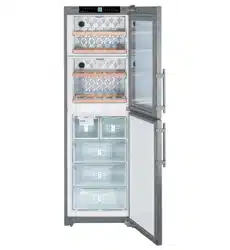Loading ...
Loading ...
Loading ...

- at room temperature
u
Food once thawed should be re-frozen only in exceptional
cases.
5.5.3 Setting the temperature in the freezer
compartment
The appliance is pre-set for normal operation.
The temperature can be set between -16 °C and -26 °C, the
recommended temperature is -18 °C.
u
To set the temperature higher: press Up button, freezer
compartment
Fig. 3 (5)
.
u
To set the temperature lower: press Down button, freezer
compartment
Fig. 3 (4)
.
w
When the button is pressed the first time, the previous value
is indicated in the temperature display of the freezer
compartment.
u
To change the temperature in 1 °C steps: briefly press the
button.
-or-
u
To change the temperature continuously: hold down the
button.
w
The value is displayed flashing during the setting operation.
w
The actual temperature is displayed approx. 5 seconds after
the button is last pressed. The temperature gradually
adjusts to the new value.
5.5.4 SuperFrost
With this function you can freeze fresh food quickly
through to the core. The appliance operates with
maximum refrigeration. The noise of the refrigeration
unit may be temporarily louder as a result.
The maximum amount of fresh food which can be frozen in 24
h is indicated on the type plate under “freezing capacity ... kg/
24h”. This amount varies according to the model and climate
rating.*
You have to activate SuperFrost in good time, depending on
how much fresh food is to be frozen: about 6 hours before
placing the food inside in case of small amounts and about 24
hours in advance in case of the maximum amount of food to be
frozen.
Wrap produce and spread it out as far as possible. Do not
allow produce to be frozen to touch produce that is already
frozen to prevent the latter thawing.
You do not have to activate SuperFrost in the following cases:
-
when placing frozen food in the freezer
-
when freezing up to approx. 2 kg fresh food daily
Freezing with SuperFrost
u
Briefly press the SuperFrost button
Fig. 3 (2)
once.
w
The LED of the SuperFrost symbol
Fig. 3 (24)
shines.
w
The freezing temperature drops, the appliance operates with
the maximum cooling capacity.
For a smaller quantity of produce to be frozen:
u
wait approx. 6 h.
u
Place wrapped produce in the top drawers.
For the maximum quantity of produce to be frozen:
u
wait approx. 24 h.
u
Remove top drawers and place produce directly on the top
shelves.
w
SuperFrost is automatically deactivated. Depending on the
quantity placed inside, after 30 h at the earliest, 65 h at the
latest.
w
The LED on the SuperFrost symbol
Fig. 3 (24)
extinguishes
once freezing is completed.
u
Place produce in the drawers and push the latter back in
again.
w
The appliance continues to operate in the energy-saving,
normal mode.
5.5.5 Drawers
Note
The energy consumption increases and the cooling perform-
ance decreases if there is insufficient ventilation.
For appliances with NoFrost:
u
Leave the bottom drawer in the appliance!
u
Always keep the air slits of the fan free at the rear wall!
u
To store frozen food directly on the shelves: pull the drawer
forwards and lift it out.
5.5.6 Shelves
u
To remove the shelf: lift up at the front
and pull out.
u
To put the shelf back: simply push in as
far as it will go.
*
5.5.7 VarioSpace
Apart from being able to remove
the drawers, you can also
remove the shelves, creating
space for large items of frozen
food. Poultry, meat, large pieces
of game and high bakery prod-
ucts can be frozen in one piece
and prepared.
u
The maximum load of frozen
food for the drawers is 25 kg
each and for the shelves
35 kg each.
5.5.8 Information system
Fig. 22
(1) Ready-made meals, ice
cream
(4) Sausages, bread
(2) Pork, fish (5) Game, mushrooms
(3) Fruit, vegetables (6) Poultry, beef/veal
The figures indicate the storage time in months for several
types of frozen food in each case. Storage times given are
guide times.
5.5.9 Cold storage accumulators
The cold storage accumulators prevent the temperature from
rising too fast in the event of power failure.
Control
* Depending on model and options 13
Loading ...
Loading ...
Loading ...
